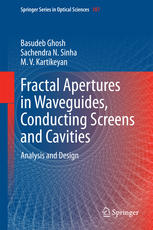

Most ebook files are in PDF format, so you can easily read them using various software such as Foxit Reader or directly on the Google Chrome browser.
Some ebook files are released by publishers in other formats such as .awz, .mobi, .epub, .fb2, etc. You may need to install specific software to read these formats on mobile/PC, such as Calibre.
Please read the tutorial at this link: https://ebookbell.com/faq
We offer FREE conversion to the popular formats you request; however, this may take some time. Therefore, right after payment, please email us, and we will try to provide the service as quickly as possible.
For some exceptional file formats or broken links (if any), please refrain from opening any disputes. Instead, email us first, and we will try to assist within a maximum of 6 hours.
EbookBell Team

4.1
60 reviewsThis book deals with the design and analysis of fractal apertures in waveguides, conducting screens and cavities using numerical electromagnetics and field-solvers. The aim is to obtain design solutions with improved accuracy for a wide range of applications. To achieve this goal, a few diverse problems are considered. The book is organized with adequate space dedicated for the design and analysis of fractal apertures in waveguides, conducting screens and cavities, microwave/millimeter wave applications followed by detailed case-study problems to infuse better insight and understanding of the subject. Finally, summaries and suggestions are given for future work.
Fractal geometries were widely used in electromagnetics, specifically for antennas and frequency selective surfaces (FSS). The self-similarity of fractal geometry gives rise to a multiband response, whereas the space-filling nature of the fractal geometries makes it an efficient element in antenna and FSS unit cell miniaturization. Until now, no efforts were made to study the behavior of these fractal geometries for aperture coupling problems. The aperture coupling problem is an important boundary value problem in electromagnetics and used in waveguide filters and power dividers, slotted ground planes, frequency selective surfaces and metamaterials. The present book is intended to initiate a study of the characteristics of fractal apertures in waveguides, conducting screens and cavities.
To perform a unified analysis of these entirely dissimilar problems, the “generalized network formulation of the aperture problems” by Mautz and Harrington was extended to multiple-aperture geometry. The authors consider the problem of coupling between two arbitrary regions coupled together via multiple apertures of arbitrary shape. MATLAB codes were developed for the problems and validated with the results available in the literature as well as through simulations on ANSOFT's HFSS.